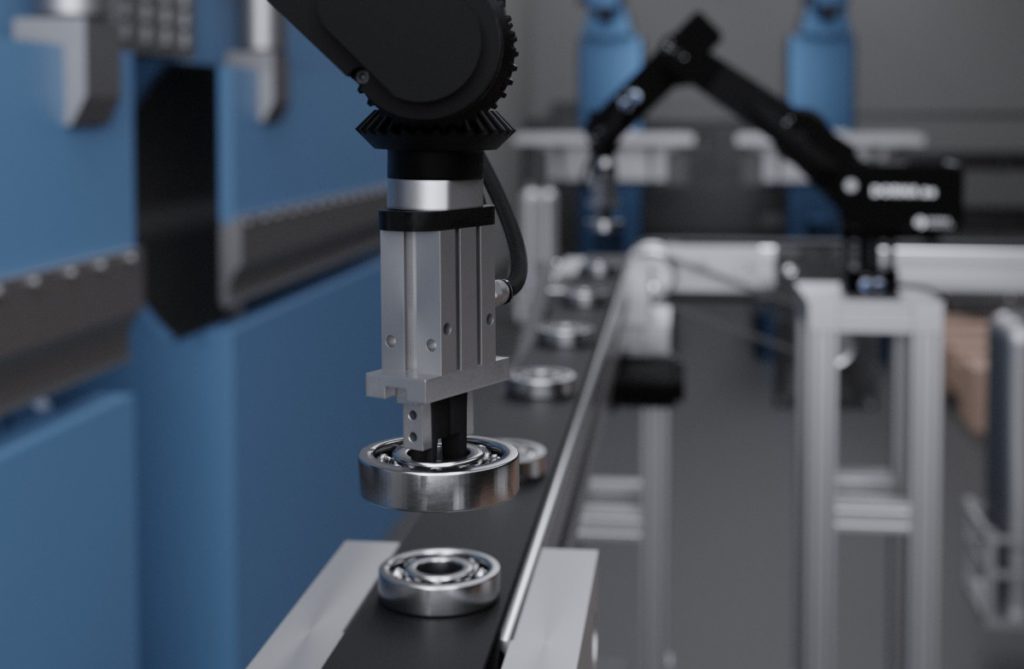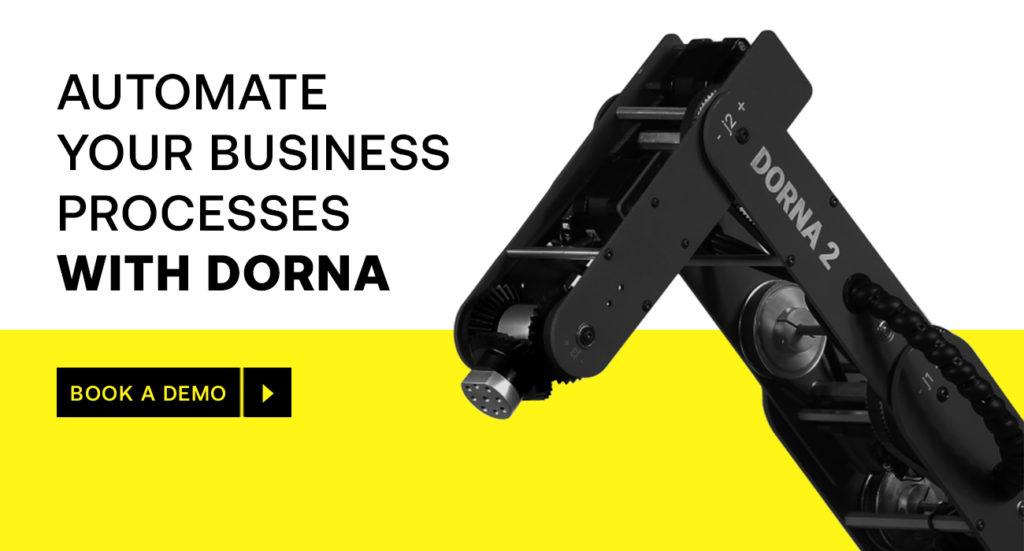Blogs, Products
A Comprehensive Guide To Types Of Robotic Arms
Robots are steadily becoming part of various industrial processes, allowing humans to sidestep monotonous, hazardous, or demanding tasks. This blog…
21 minute read
In This Article
In the ever-advancing landscape of industrial automation, pick and place robots stand out for their unparalleled ability to streamline and optimize repetitive tasks.
These robots, purpose-built for the meticulous handling of objects, play a pivotal role in lifting and relocating items across diverse sectors. This is why the inexorable rise of pick and place robots has led to a paradigm shift towards increased efficiency, reduced labor costs, and enhanced precision in manufacturing processes. As one dives into their intricacies, it becomes evident that their significance extends far beyond mere mechanical movements; they are changing the ways of manufacturing on a global scale.

This blog aims to explore the essence of pick and place robots, providing a comprehensive understanding of their components, operational principles, and their transformative impact on industries worldwide.
The inception of pick and place robots in the mid-20th century marked a milestone in the evolution of automation. Today, designed to alleviate the burden of repetitive tasks, these robots have found their niche across an array of industries.
From manufacturing lines to logistics hubs and electronics assembly, pick and place robots have become indispensable, catalyzing efficiency and precision. Their popularity is also a testament to the growing need for automation in general, where human limitations are surpassed by the tireless and precise execution of these robotic systems.
Several industries, as a result, have embraced pick and place robots for their ability to seamlessly integrate into existing workflows, offering a scalable solution for diverse applications. The demand for increased productivity and reduced errors has fueled the rapid adoption of these robots, paving the way for a new era in industrial automation. It is, hence, more than evident that the impact of pick and place robots extends beyond the confines of a single sector; it’s reshaping the landscape of work and production.
At the heart of every pick and place robot lies a sophisticated amalgamation of components that collaboratively enable seamless object manipulation. These include:
A fundamental element of these robots is the arm that serves as the mechanical extension responsible for precise movements. The design of these arms varies, ranging from articulated arms, mimicking human limbs, to gantry arms, ideal for linear movements in confined spaces. This flexibility allows pick and place robots to adapt to diverse tasks with unparalleled accuracy.
Complementing the robotic arm, the end-effector serves as the hand of the system, playing a crucial role in grasping and releasing objects. The design of end-effectors varies based on the specific requirements of the task at hand. Grippers, suction cups, or magnetic attachments are common variations, each tailored to handle objects of different shapes, sizes, and materials. This adaptability ensures the versatility of pick and place robots across various industries.
In tandem with the above mechanical components, sensors form the neural network of these robots. Vision systems, proximity sensors, and other advanced sensors endow pick and place robots with a keen awareness of their surroundings. These sensors play a pivotal role in detecting objects, assessing distances, and ensuring precise movements, enhancing the overall efficiency and safety of the robotic system.

The robotic arm, as discussed above, serves as the quintessential limb of a pick and place robot, dictating the range and precision of its movements. The two common types of robotic arms today are articulated robotic arms and gantry arms, each with varying functions and capabilities.
Articulated robotic arms, characterized by multiple joints mirroring the human anatomy, offer unparalleled flexibility. This flexibility proves invaluable in navigating complex environments and manipulating objects with varying orientations.
Gantry arms, on the other hand, are designed for linear movements along predefined paths. These arms find their niche in situations where precision along a specific trajectory is paramount. Their controlled, repetitive motions make them ideal for tasks requiring consistency, such as assembly line operations.
Programming lies at the core of a robotic arm’s functionality. Through meticulous coding, these arms are directed to perform specific tasks with utmost precision. Whether it’s picking and placing components in manufacturing or organizing items in a warehouse, the adaptability of robotic arms is harnessed through precise programming, making them indispensable in the realm of automation.
The end-effector, often referred to as the “robotic hand,” is a pivotal component that defines the interaction between the pick and place robot and the objects it handles. These versatile attachments, ranging from grippers to suction cups, are carefully chosen based on the nature of the task at hand. Grippers, equipped with adjustable jaws or fingers, excel in securely holding objects of various shapes, providing a robust grip during lifting and placing operations.
Suction cups, an alternative end-effector, leverage vacuum technology to adhere to surfaces, making them ideal for handling smooth or delicate items. This adaptability in end-effector design allows pick and place robots to tackle a spectrum of materials and products, ensuring efficiency and precision across diverse applications.
The selection of the appropriate end-effector is a strategic decision, driven by factors such as the weight, size, and fragility of the objects to be manipulated. This nuanced approach underscores the sophistication of pick and place robots, as they seamlessly transition between different end-effectors to accommodate the specific demands of each task.
Sensors play a pivotal role in elevating pick and place robots from mere machines to intelligent entities capable of perceiving and responding to their environment. Vision systems, equipped with cameras and image recognition algorithms, enable robots to “see” and identify objects with precision. This visual feedback is crucial for tasks that require object detection, sorting, or quality control.
Proximity sensors add another layer of awareness, allowing pick and place robots to gauge distances accurately. These sensors contribute to the robot’s ability to approach objects with the right level of proximity, facilitating a smooth and controlled pick and place operation. Additionally, force sensors provide feedback on the pressure exerted during gripping, preventing damage to delicate objects.
Regularly calibrate and fine-tune the sensors to ensure accurate and reliable readings, adapting the sensors to specific tasks and environmental conditions. This is so the synergy between these sensors creates a real-time feedback loop, empowering pick and place robots to adapt dynamically to changes in their environment. This heightened awareness not only enhances operational efficiency but also ensures the safety of both the robotic system and its human counterparts in shared workspaces.
As technology advances, the integration of more sophisticated sensor technologies continues to refine the capabilities of pick and place robots, ushering in an era of heightened precision and adaptability.

The pervasive influence of pick and place robots extends across a multitude of industries, reshaping traditional workflows and redefining efficiency standards; some of these are:
In this industry, these robots ensure the precise assembly of intricate components, optimizing production lines for increased output.
These robots navigate warehouses with dexterity, expediting the sorting and distribution of goods in the logistics industry.
This industry benefits from these robots’ delicacy in handling intricate circuitry, minimizing the risk of damage.
From automotive plants to e-commerce fulfillment centers, pick and place robots have become indispensable collaborators in the pursuit of heightened productivity and accuracy. Their ability to adapt to the unique demands of each sector underscores their versatility, making them an integral part of the fourth industrial revolution.

The transformative operational prowess of pick and place robots lies in the seamless integration of their components. The operational principles emphasize a meticulous fusion of mechanical precision, intelligent sensing, and adaptability. All of these position pick and place robots as the linchpin in automating intricate tasks across diverse sectors.
Dorna is a leading manufacturer of pick and place robots in the industry and a trusted automation partner for businesses since 2018. Book a demo with Dorna today and revolutionize the way you handle pick and place tasks in your production line.
As technology advances, these robots are poised to redefine the boundaries of automation, heralding a future where innovation and efficiency walk hand in hand.
Take the first step today!
Blogs, Products
Robots are steadily becoming part of various industrial processes, allowing humans to sidestep monotonous, hazardous, or demanding tasks. This blog…
21 minute read
Blogs
Robotic automation, in particular, is emerging as a transformative force that can revolutionize processes, optimize resources, and drive growth. However,…
32 minute read
Blogs, Products
In this blog, we embark on a comprehensive exploration of the top challenges associated with the adoption of robotic arms…
29 minute read
Blogs
This blog explores different gripper types, their features, applications, and how they improve production efficiency.
32 minute read